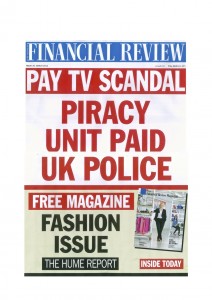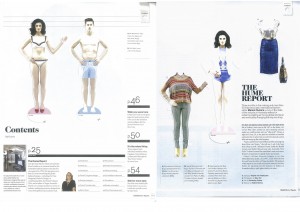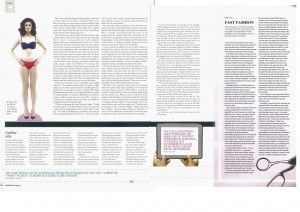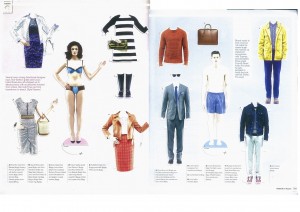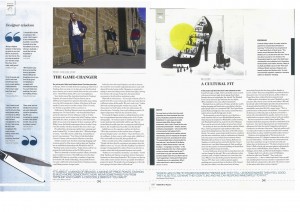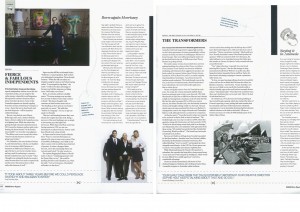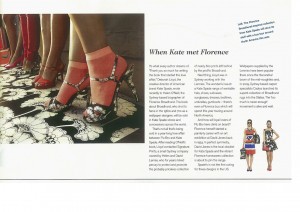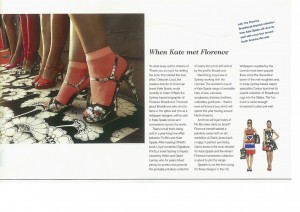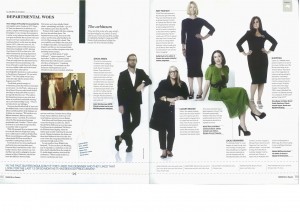Category Archives: Columns
Bentley – Australian Financial Review
by Marion Hume
Can I start by saying I don’t like cars? Couldn’t care less about them. Indeed, I am so not engaged with the world of hot rods, that every time I book my trusty minicab driver to collect me from an event, he has to get out of the car when I wander outside because, while I rarely forget a face, cars, well, I know his is silver but that’s all I can tell you.
So when, out of the blue, I was offered the chance to test-drive a Bentley, I shrugged, “Nah, not my thing”. You know the expression “steam coming out of your ears”? I actually think I saw that happening to my husband. Hence some backtracking and then a Bentley delivered to my door, (here, bear in mind I live in Riot Central, North London). I must state this treat was unconnected to AFR, (I write for other publications in the UK). I’m mentioning it because AFR’s readers are wealthy enough to buy fast cars. As to how much wealth you might need, don’t ask me. As I said; cars, couldn’t care less.
That was until I confronted a mighty power that goes way beyond a handbag’s. My neighbours; hard scrabble Londoners, came out of their doors not to key the car, but to purr. I let one of them sit inside, because he’s good at setting a GPS, while I finished a few phone calls. My lack of interest was genuine – until I got inside the vehicle.
What extraordinary, practical, beautiful, lovingly crafted design! And the smell of that leather; no wonder they are always trying to bottle it for men’s fragrance. On looks alone + the button that made the seat glide back, I was smitten, although the test drive was spoiled a bit by my realization I should have had my hair done up in a chignon.
Later, I was asked to comment on how design might be improved. I am surprised my suggestion of a device that says, “you cannot afford me” to those who get too close has not been taken on board. For it is disconcerting when you are trying to park and men in bad sandals start to stroke your vehicle.
Still, my other suggestion (not implemented either) of a bumper sticker reading “I’m not a footballer’s wife” must have been deemed innovative enough to score me an invitation to the London launch of a limited edition Continental Spur a few weeks’ later. This car can be ordered in a deep shade of chocolate brown, which, I assure you, is the new black. The armrest between the rear seats folds down to reveal a bar fridge. The make-up mirrors have better lighting than a West End theatre dressing room.
You, of course, already know a Bentley is a treasure-trove of great design. Whereas I am like the Chinese; on a voyage of discovery. In 2002, Bentley sold 41 cars in China. In 2011, it sold 1,103 from 13 dealerships. How much is a Bentley in China? Oh why sweat the small stuff? If I were a newly-minted billionaire, I’d be first in line with a big bag of yuan.
Have I been suckered in? Of course. Yet the experience has been useful. For I am left wanting something I know I can never own. I have spent so many years covering fashion, I realise I have become largely immune to feelings of covetousness. Those with their noses pressed against the glass, looking at handbags they can’t afford? BB (Before Bentley), I’d be saying something logical, like, “At the end of the day, a duck egg blue Birkin is not that practical. You’ll find another bag”. AB (After Bentley) despite recognizing the wisdom of “Thou shalt not covet thy (billionaire) neighbour’s Bentley”, I feel that pain.
Luxury Luggage – Australian financial review
by Marion Hume
This column’s territory is luxury, but as with any landscape, there are beauty spots and eyesores. When luxury lets you down, the feeling you get is sort of like when someone builds a condo in your view.
There is nothing more galling then investing in chic only to find it behaves like cheap. The brand names have been left out from what follows only because I’m on deadline so can’t give them right to reply. But one brand already knows it’s them, the next will guess and the third is going to be hearing from me, although I concede the latter might not be the scariest threat in the world.
Example one. An elegant man about town invested in a snazzy leather iPad case. Please note the word “case”, for which the dictionary definition is “receptacle, holder”. iPads are all about being connected on the move, so he moving, when he was caught in a Sydney storm. Did he use his iPad cover as an umbrella? He did not. He protected it and its contents as best he could as he ran for cover, which didn’t, alas, stop his good suit getting soaked. That sprang back to form once dry. Alas, instead, the iPad cover developed what the beauty business terms “deep set wrinkles”, this because beneath the butter soft leather lay cardboard gone limp. The brand response? No they wouldn’t take it back because the cover should not have been exposed to rain. In truth, it did recover a bit – the wrinkles are reduced to “fine lines” – but the fact is, he’s stuck with it.
Example two. A self-made, glamourous wife buys a suit for her dashing husband. The word “suit” rather suggests its purposes include suiting the wearer, except it doesn’t. It i is neither too large or too small, it just looked wrong. “Because you have removed the (nasty, plasticky) swing tag, we won’t exchange it,” she was told. It’s currently hanging in the wardrobe like a reproach.
Our final example concerns a well travelled woman we’ll call Marion because, obviously, she’s me. I invest in my luggage – not the kind with other people’s initials all over it which comes with another bag to protect the bag – I cannot see the point of that – instead bags from expert luggage makers with an esteemed heritage and a reputation for offering innovative, durable, practical designs, which is surely what one wants in a suitcase.
Thumbnail story; I buy suitcase in morning, pack for Singapore, fly that night. I fly on to Auckland, and – here’s the marvelous bit – not once do I have to lug my own bag. Instead, its first taste of long haul is on a series of trolleys, even though it has four study wheels of its own. So the first time I use the pull-out handle is in Sydney and it comes clean off in my hand. I send an email expecting I will be directed to that global free repair service the website boasts of. Instead it reads, “just take it back to the store on your return to London”. Excuse me? As much trumpeted customer service goes, that rates as absolutely useless. “Do you have your receipt?” they say when I call the Sydney store listed on the company website. “Yes, filed at home in London, as I was instructed to keep it safe with the warranty”. “Well, I can’t think why you didn’t pack the receipt” is the frankly sniffy response. Readers, do you take your luggage receipts on a two-month business trip? Maybe I’m being dumb here?
But didn’t the customer used to be right, or at least given a fair hearing? Consumers have embraced the, to me, hideous notion that cheap T shirts won’t survive a second wash but part of the luxury promise is longevity.When you buy into posh, a bit of you falls in love and when it fails, you are a little bit heartbroken.
Rainbow – Australian financial review
by Marion Hume
How can you copyright a colour? The notion seems ludicrous. Imagine some swaggering luxury goods titan looking up at a rainbow and pronouncing, “I want red for this brand, orange for that brand, worldwide usage for yellow, all rights for green and I’m banning anyone else from blue, indigo, violet.”
Yet who owns what tone has become a hot topic. A while back, I was asked to write a letter in support of the French shoemaker, Christian Louboutin’s right to red and I was happy to do so. Louboutin’s red soles are a potent brand signifier. So no wonder he saw red and sued when Yves Saint Laurent offered red soled shoes too. The presiding judge found against him noting that no one designer should have a “monopoly” on any color. At time of writing, the case is on appeal.
Louboutin became associated with red by accident. He thought the black soles of his first designs for high heels looked depressingly dull so he grabbed some nail lacquer and added D.I.Y. pizazz. Does he own red? Powerful forces rallying to his support certainly hope so. Tiffany & Co. has filed something called an amicus curiae because if Loubi loses, who owns the blue the jewellers have been using since 1845?
There’s no question, surely, that Hermes owns orange. Yet like Loubi-red, Hermes orange was an accident. Until the end of the 1930s, the company’s packaging was brown. But under the Nazi occupation, paper stock became near-impossible to find. Someone heard of a cake shop that had had to close. The sunny packaging in which people had carried home gateaux in happier times was available because other luxury marques thought it too vulgar. And so orange came to signify hope, then chic and now – certainly if it is me who is the lucky recipient of an Hermes gift – absolute joy.
Hermes orange has gone even further, to the point that it is synonymous with Paris itself, for orange = Hermes = Parisian chic. Yet when you look at the fabric of Paris, it isn’t orange of course, it’s dove grey or in the watery light of early spring, the most ravishing lavender. And hardly anyone in Paris ever wears orange, with the exception of the Australian, Marc Newson, who has a penchant for vivid windcheaters.
Elsewhere, when nature, light and beautiful architecture can’t be called upon, a splash of bright paint can be transforming in how we see a city. I’ve never been to Tirana, Albania, among the most isolated capitals in Europe. But my interest was piqued when the mayor decreed that brutalist architecture – and thus citizens’ lives – could be improved with bold stripes of yellow, green, blue and red applied all over the tower blocks. Similarly, in the favelo of Rio and the slums of Nairobi, painting rundown buildings in vibrant colours is starting to have the effect of cutting criminality, which it turn gives locals more power over their lives.
This isn’t new to me. In 1851, a social experiment took place in a notorious London slum. When a row of cheap little terrace houses went up, each was rendered and painted a different colour to see if poor people might behave better if they lived in pretty houses. As my neighbours and I quip today, as we stand outside homes still painted primrose, pistachio and rose, we do. We also know our street brightens the day of many who walk through because they stop and tell us so. Colour is cheerful. Should fashion designers ever get ownership of it, then? I think, sometimes, yes. But given my suspicions that there are luxury goods titans out there would love to project brand logos onto the moon if we let them, we must stay vigilant. We hold the monopoly on how we colour our world.

